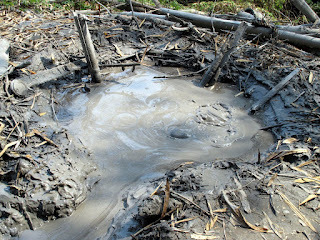On my main blog, I've just posted a 1,532-word article I wrote for a local magazine about birdwatching along Taiwan's southwestern coast. If you're keen to see migratory waterbirds, you may find it useful.
Thursday, March 29, 2012
Wednesday, March 21, 2012
Tianliao's mud volcano
 Mud volcanoes enthrall me, so a little while back I rode my motorcycle out to Kaohsiung City's Tianliao District (高雄市田寮區) in search of a mud volcano marked on some maps of the area. En route, I passed through some of south Taiwan's most striking "moonworld" scenery; I took the photo above near where Freeway 3 goes under Zhongliaoshan (中寮山 ), a 421m-high peak topped by military and civilian telecommunications equipment.
Mud volcanoes enthrall me, so a little while back I rode my motorcycle out to Kaohsiung City's Tianliao District (高雄市田寮區) in search of a mud volcano marked on some maps of the area. En route, I passed through some of south Taiwan's most striking "moonworld" scenery; I took the photo above near where Freeway 3 goes under Zhongliaoshan (中寮山 ), a 421m-high peak topped by military and civilian telecommunications equipment.
The volcano itself is difficult to find if don't read any Chinese. From Tianliao itself, head east on Highway 28, over Freeway 3 to the community of Chongde (崇德). Then take Kaohsiung Road 141 on the right. After less than 1km, you'll see Chongde Elementary School (崇德國小). The mud volcano is a further 1.5km east; keep your eyes peeled for Chinese-language signs reading 泥火山. Opposite a chicken farm, you'll find some rough concrete steps going up into a bamboo forest on the right-hand side of the road. The volcano is less than 100m away.
In visual terms, Chongde's volcano is less exciting than the better-known eruption at Wushanding (烏山頂) about 9km to the south. There's no cone as such, rather a 1m-wide belching hole in the ground. I picked up a bamboo almost as long as I am tall and stirred the hole. This seemed to cause an outbreak of bubbling; the stick wasn't long enough to probe the bottom of the vent, pictured below.
Sunday, March 11, 2012
Industrial heritage in Taiwan
 I find old industrial sites fascinating, and I'm lucky because Taiwan has dozens. In the past 20 years, as Taiwan's economy has shifted from one based on heavy industry and manufacturing to one that focuses on services and high technology, dozens of sugar refineries, mines and ordinary factories have been closed down. Several have been preserved and reopened as tourist attractions; they're especially popular with local school groups as they help youngsters understand how their grandparents earned a living in the 1960s and 1970s. A handful of still-operating, century-old facilities can also be visited. Even if the function of such places doesn't interest you, you'll likely enjoy the architecture.
I find old industrial sites fascinating, and I'm lucky because Taiwan has dozens. In the past 20 years, as Taiwan's economy has shifted from one based on heavy industry and manufacturing to one that focuses on services and high technology, dozens of sugar refineries, mines and ordinary factories have been closed down. Several have been preserved and reopened as tourist attractions; they're especially popular with local school groups as they help youngsters understand how their grandparents earned a living in the 1960s and 1970s. A handful of still-operating, century-old facilities can also be visited. Even if the function of such places doesn't interest you, you'll likely enjoy the architecture.
One of the country's best-known sights of this kind is Taiwan Balloons Museum (who provided the photo here) in Taichung. A government-sponsored website, Tourism Factories of Taiwan, has short descriptions, addresses and opening hours for 53 sights.
Wednesday, March 7, 2012
Fresh Fact VI: Ladybirds
This I recently learned from a television program:
Taiwan has 1/4,000th of the Earth's dry land, yet a remarkable 250 of it's 5,000-odd ladybird (or as they're called in North America, ladybug) species.
Friday, March 2, 2012
Temple reconstruction
 Many temples in Taiwan have a long history, but in relatively few instances is the structure itself more than a century old. Depending on how wealthy a temple is, the building may be torn down and rebuilt from scratch - or at least refurbished beyond recognition - every two or three generations. An Australian who worked on Dalongdong Baoan Temple (one of Taipei's finest) said this:
Many temples in Taiwan have a long history, but in relatively few instances is the structure itself more than a century old. Depending on how wealthy a temple is, the building may be torn down and rebuilt from scratch - or at least refurbished beyond recognition - every two or three generations. An Australian who worked on Dalongdong Baoan Temple (one of Taipei's finest) said this:In Western culture we are absolutely fixated on the preservation of the object, but in Chinese culture it is the concept that is all important – the object is merely an expression of the concept. Thus the replacement of elements in an artefact is carried out as a matter of course. 'Old' temples have been rebuilt many times... Generally there is little effort to replicate the original, though the design and layout is predetermined by custom. Renovation is seen as an opportunity for improvement – to use richer materials and to use craftsman of even greater skill than previously.
I came across the semi-renovated shrine pictured above during a recent trip into Kaohsiung's backcountry. Clearly, the first stage of the process had been to strip the building of everything but the basic
concrete-and-rebar. Private homes are often renovated in the same manner.
Subscribe to:
Comments (Atom)

